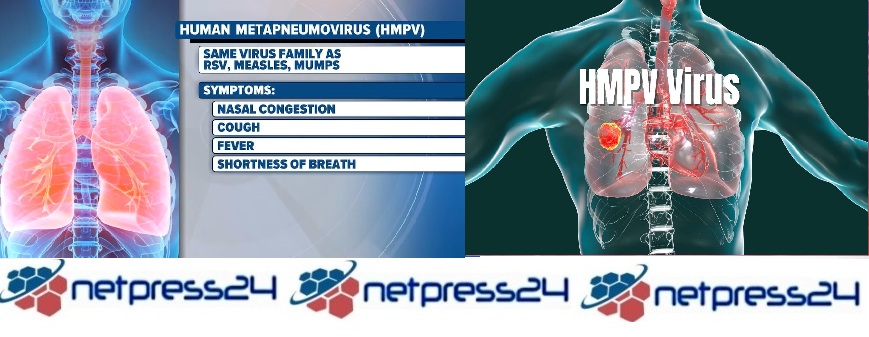Rising Cases of HMPV: Symptoms, Diagnosis, and Prevention.
Rising Cases of HMPV: Symptoms, Diagnosis, and Prevention.
Human Metapneumovirus (HMPV) is a respiratory virus
that has been causing significant concern worldwide due to recent outbreaks.
While it is not as widely known as other viruses like COVID-19, it can cause
severe illness, particularly in vulnerable groups. It is similar to other
viruses like the common cold or flu, but it can sometimes lead to more serious
illness, especially in young children, older adults, and people with weakened
immune systems. HMPV was first identified in 2001 and is responsible for a
range of respiratory illnesses, from mild cold-like symptoms to more severe
conditions such as pneumonia and bronchiolitis. It is transmitted through
respiratory droplets when an infected person coughs, sneezes, or talks. People
can also get infected by touching contaminated surfaces and then touching their
face.
Symptoms of HMPV:
HMPV infections can cause mild to severe respiratory symptoms. These include:
Mild Symptoms:
Runny nose
Cough
Sneezing
Fever
Sore throat
Severe Cases:
In some instances, HMPV can lead to complications such as bronchitis or pneumonia, especially in young children, the elderly, and individuals with weakened immune systems.
How Is HMPV Diagnosed?
Human metapneumovirus (HMPV) is diagnosed using tests like a nasal swab or throat sample to detect the virus. These samples are analyzed with techniques such as PCR (polymerase chain reaction) or antigen detection.
What Can Be Done to Stop the Spread of HMPV?
The good news is that with proper precautions, the spread of HMPV can be slowed. Here are some steps that can be taken globally to curb the virus's transmission:
Promote Hygiene and Hygiene Education:
Governments and health organizations should emphasize frequent handwashing, especially during flu season. People should wash their hands for at least 20 seconds with soap and water, or use alcohol-based hand sanitizers. Public health campaigns should encourage people to cover their mouth and nose with a tissue or elbow when coughing or sneezing.
Avoid Close Contact with Infected Individuals:
People should avoid close contact with those who show symptoms of respiratory illnesses. Schools, daycare centers, and workplaces should implement policies to keep sick children and employees home until they recover.
Vaccination and Research:
While there is currently no vaccine for HMPV, research into developing one should be a global priority. Governments and health organizations should fund studies aimed at understanding the virus better and creating vaccines and antiviral treatments.
Strengthen Healthcare Systems:
Hospitals, especially in regions prone to outbreaks, should be prepared with the necessary equipment to handle respiratory illnesses. Health systems must ensure that sufficient medical supplies, such as oxygen therapy and ventilators, are available for severe cases. Staff should be trained to recognize symptoms of HMPV and differentiate it from other respiratory infections like COVID-19 and influenza.
Implement Travel Restrictions if Necessary:
In the event of a severe outbreak, countries may consider travel advisories or restrictions to prevent the spread of HMPV. These measures should be temporary and targeted to areas with the highest infection rates.
Global Outbreaks and Affected Populations:
In recent months, HMPV has been spreading in various countries, with notable outbreaks in Asia, including China and India. The surge in cases has sparked concerns among health authorities, particularly due to the virus’s potential to overwhelm healthcare systems if not managed properly.
China's Surge in Cases:
In December 2024, Chinese health officials reported an increase in HMPV infections, especially among children under 14 years old. The Chinese CDC noted that around 6.2% of positive respiratory illness tests were attributed to HMPV, surpassing other viruses like COVID-19 in some areas. Hospitals in major cities like Beijing and Shanghai have seen a rise in admissions, particularly among young children who develop severe respiratory symptoms.
India's Monitoring Efforts:
While India has not seen the same level of outbreak as China, health authorities have begun closely monitoring HMPV cases, especially as the winter season sets in. The Indian Ministry of Health has issued guidelines for managing respiratory illnesses, and hospitals in regions with high flu rates are on alert for potential HMPV cases.
Other Countries Affected:
Countries such as South Korea, Japan, and several in Southeast Asia have reported seasonal spikes in HMPV infections, primarily affecting young children and the elderly. This pattern is consistent with the virus’s typical seasonal behavior, with an increase in cases during the colder months.
While HMPV has not reached the scale of a pandemic like COVID-19, its ability to cause significant illness in vulnerable populations makes it a global health concern. By maintaining good hygiene, avoiding close contact with infected individuals, and supporting research efforts, the spread of HMPV can be managed effectively. Governments, healthcare professionals, and individuals all have a role to play in preventing widespread outbreaks of this respiratory virus.



















Post a Comment